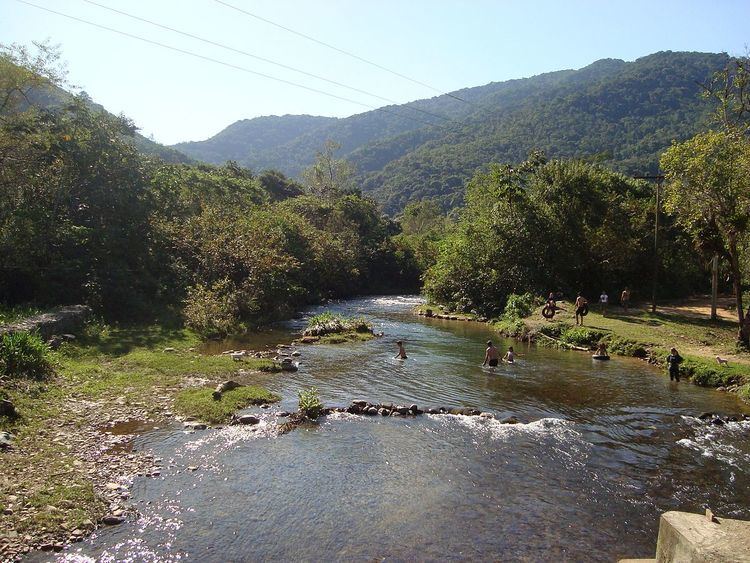Website www.petar.com.br Phone +55 15 3552-1875 | Created 19 May 1958 Area 357.1 km² Management Instituto Florestal | |
 | ||
Hours Closed today Shrove Monday might affect these hoursMonday(Shrove Monday)ClosedTuesday(Mardi Gras)8AM–5PMHours might differWednesday8AM–5PMThursday8AM–5PMFriday8AM–5PMSaturday8AM–5PMSunday8AM–5PM Similar Pousada das Cavernas, PETAR Pousada Casa de, Pousada da Diva, Caverna Santana, Pousada do Quiririm | ||
Petar e as cavernas do vale do ribeira documentario
The Alto Ribeira Tourist State Park (Portuguese: Parque Estadual Turístico do Alto Ribeira) is a state park is the state of São Paulo, Brazil. It protects a mountainous area of Atlantic Forest. It is known for its many caves.
Contents
- Petar e as cavernas do vale do ribeira documentario
- Location
- History
- Environment
- Facilities
- Caves
- Nucleo Casa de Pedra
- Located in the Nucleo Santana
- Located in the Nucleo Caboclo
- Open for visitation
- References
Location
The Alto Ribeira Tourist State Park is divided between the municipalities of Apiaí and Iporanga in São Paulo. It has over 350 caves, many waterfalls, trails and archaeological and paleontological sites. There are traditional and quilombola communities in the park. It lies 320 kilometres (200 mi) from São Paulo There are four visitor centers and support for enforcement activities and research in order to safeguard and protect the rich natural heritage of the upper Ribeira region, represented by the important biodiversity of the remnants of the Atlantic forest and its paleontological, archaeological and historical sites. It is home to one of the most important speleological provinces in Brazil with more than 300 caves registered by the SBE - Sociedade Brasileira de Espeleologia.
History
The Alto Ribeira Tourist State Park is one of the oldest parks in the state of São Paulo, created by state decree 32,283 of 19 May 1958. From the 1990s it became popular for adventure sports such as climbing, rafting and cycling and for environmental education, photography and observation of nature.
São Paulo state decree 58.148 of 21 June 2012 created the Paranapiacaba Conservation Units Mosaic, consisting of the Alto Ribeira Tourist State Park, Intervales State Park, Carlos Botelho State Park, Xitué Ecological Station, Nascentes do Paranapanema State Park and the Serra do Mar Environmental Protection Area in the municipalities of Eldorado, Sete Barras, Tapiraí, Juquiá, Ribeirão Grande and Capão Bonito. The purpose was to promote integrated and participatory management of the conservation units, and to seek to guarantee conservation of the areas covered.
Environment
There are a great many streams and rivers. Flora include the Palmito Juçara (Euterpe edulis) and many species of bromeliads and orchids. Birds species include fasciated tiger heron (Tigrisoma fasciatum) and ornate hawk-eagle (Spizaetus ornatus). Large mammals include lowland paca (Cuniculus paca), South American tapir (Tapirus terrestris) and howler monkeys.
Facilities
The park has four visitor centers. Most tours of the parks require a local guide. The Ouro Grosso center is a base for courses on environmental monitoring, seminars and meetings and provides accommodation for public school students. Other than the caves, attractions include:
Caves
The caves are the main attraction. Some have stairs, walkways and bridges to facilitate access, some contain large rivers. Only four are open to visitors.
The presence of caves in conjunction with the Atlantic Forest, encourages the visitor to know a variety of environments, going through some rivers, swim in the waterfalls outside and inside caves. Its wide range of itineraries may please the most demanding of both beginners and veterans. It has four main areas or units for tourist visitation: Nucleo Santana, Ouro Grosso, Casa de Pedra and Caboclos. The most frequented are Santana and Ouro Grosso.
Nucleo Casa de Pedra
Located in the Nucleo Santana
Located in the Nucleo Caboclo
Open for visitation
The caves which are open for visitation read as follows:
